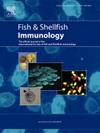感染内脏白结核病的大黄鱼脾脏相关性状的机器视觉辅助基因组预测和全基因组关联。
IF 4.1
2区 农林科学
Q1 FISHERIES
引用次数: 0
摘要
在旨在应对现代育种模式挑战的创新技术的推动下,鱼类的高分辨率和高通量基因型到表型研究正在迅速发展。近年来,机器视觉和深度学习技术,特别是卷积神经网络(CNNs),在图像识别和分割方面取得了巨大成功。此外,抗病性的定性和定量分析一直是遗传学研究的重要领域。基于这一动机,我们研究了大黄鱼内脏白结核病(VWND)在编码抗病性信息方面的潜力,以完成入药分类任务。在这项研究中,我们提出了一种基于机器视觉的图像分割框架,用于提取 VWND 感染后脾脏的特征。我们利用深度 CNN 和阈值分割技术进行自动特征学习和对象分割。与手工创建特征相比,这种方法消除了主观性,提高了工作效率。此外,我们还利用脾脏相关性状进行了全基因组关联分析(GWAS),从而确定了 24 个重要 SNP 和 10 个主要数量性状位点。候选基因的功能富集分析结果也显示了与免疫调节机制的潜在关系。此外,我们还探索了基因组选择(GS)技术在极端个体表型预测中的应用,这进一步支持了大黄鱼抗VWND脾脏相关表型的可预测性。我们的研究结果表明,基于人工智能(AI)的表型分析方法可以为遗传学研究提供最先进的性能。我们希望这项工作能为深度学习和机器视觉在水产养殖物种表型分析中的应用提供一个范例。本文章由计算机程序翻译,如有差异,请以英文原文为准。
Machine vision-assisted genomic prediction and genome-wide association of spleen-related traits in large yellow croaker infected with visceral white-nodules disease
High-resolution and high-throughput genotype-to-phenotype studies in fish are rapidly advancing, driven by innovative technologies that aim to address the challenges of modern breeding models. In recent years, machine vision and deep learning techniques, particularly convolutional neural networks (CNNs), have achieved significant success in image recognition and segmentation. Moreover, qualitative and quantitative analysis of disease resistance has always been a crucial field of research in genetics. This motivation has led us to investigate the potential of large yellow croaker visceral white-nodules disease (VWND) in encoding information on disease resistance for the task of accession classification. In this study, we proposed an image segmentation framework for the feature extraction of the spleen after VWND infection based on machine vision. We utilized deep CNNs and threshold segmentation for automatic feature learning and object segmentation. This approach eliminates subjectivity and enhances work efficiency compared to using hand-crafted features. Additionally, we employed spleen-related traits to conduct genome-wide association analysis (GWAS), which led to the identification of 24 significant SNPs and 10 major quantitative trait loci. The results of function enrichment analysis on candidate genes also indicated potential relationships with immune regulation mechanisms. Furthermore, we explored the use of genomic selection (GS) technology for phenotype prediction of extreme individuals, which further supports the predictability of spleen-related phenotypes for VWND resistance in large yellow croakers. Our findings demonstrate that artificial intelligence (AI)-based phenotyping approaches can deliver state-of-the-art performance for genetics research. We hope this work will provide a paradigm for applying deep learning and machine vision to phenotyping in aquaculture species.
求助全文
通过发布文献求助,成功后即可免费获取论文全文。
去求助
来源期刊

Fish & shellfish immunology
农林科学-海洋与淡水生物学
CiteScore
7.50
自引率
19.10%
发文量
750
审稿时长
68 days
期刊介绍:
Fish and Shellfish Immunology rapidly publishes high-quality, peer-refereed contributions in the expanding fields of fish and shellfish immunology. It presents studies on the basic mechanisms of both the specific and non-specific defense systems, the cells, tissues, and humoral factors involved, their dependence on environmental and intrinsic factors, response to pathogens, response to vaccination, and applied studies on the development of specific vaccines for use in the aquaculture industry.
 求助内容:
求助内容: 应助结果提醒方式:
应助结果提醒方式:


